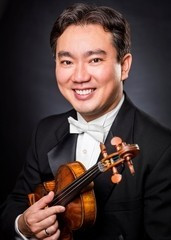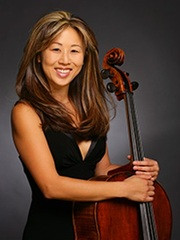|
Back
A Summery Executionist New York
David Geffen Hall, Lincoln Center
06/02/2016 - & June 3, 4, 2016
Edvard Grieg: The Last Spring
Astor Piazzolla: Las cuatro estaciones portebas (Arranged by Leonid Desyatnikov)
Antonio Vivaldi: Le quattro stagioni, Opus 8, Nos 1-4
Frank Huang (First Violin/Conductor/Soloist), Paolo Bordignon (Harpsichord)
New York Philharmonic Orchestra

F. Huang (© Chris Lee)
Who (one might ask) could possibly not love Astor Piazzolla? His teachers Alberto Ginastera and Nadia Boulanger adored his music. So did Stravinsky, Bartók, Rostropovich, Emmanuel Ax, the Kronos, and Chick Corea. So did the subscription audience to the New York Phil this weekend. So does the world.
The world, that is, except for your ordinary Argentinian.
If you put Piazzolla and Tango in the same sentence, they will glare at you. My East Village neighbor’s restaurant, “Cafe Paradiso” is only three blocks from where the composer lived for many years. Yet, he told me, his own father–like Piazzolla, an Italian immigrant to Buenos Aires–would shut down the radio with anger when music by Piazzolla came on.
“Argentinians are so proud of their own tango,” he explained, “that they take no pride in Piazzolla at all. They say that Piazzolla might have been a success internationally, but he had destroyed the real dance of their country.”
Piazzolla himself had indeed tried to outdo his own success by “going classical”, until his teacher, the great Nadia Boulanger, told him that she had heard many composers in his music. But ”Where”, she asked, ”was Astor Piazzolla?”
At that point, Piazzolla realized that the best of himself was his own unadulterated genius. And the music of the tango, which came so naturally to him. Piazzolla’s problem was that the tango that came out of his psyche became, in his glorious hands, the New Tango. And that did not please the many thousands of Argentina people who believed he had virtually spat on the Crucifix of the Old Traditional Tango, the dance not of love or tragedy, but the dance of sex.
So Piazzolla, who changed pure sex into love and beauty and tragedy, embellishing his music with nuances and homages to Bach, and Stravinsky. made his fortune, yes. But rarely in his native Argentina. Paris, Central Europe and America were this nomad’s homelands.
In fact, that was the story of last night’s The Four Seasons of Buenos Aires. Piazzolla had never written such a work. He had written several songs for his accordion-like bandoneón with violin/viola, piano, electric guitar and double bass. Later, he and the quintet put them together as “Four Seasons”. And while not exactly tango-ish, they are delightful as chamber music.
But whatever was left of their native origin was transposed once again, this time by a serious Russian composer named Leonid Desyatnikov. He had been commissioned by violinist Gidon Kremer to re-orchestrate these songs to be played by himself and a string orchestra. And while Kremer is rarely wrong, he destroyed what was left of the tango.
So in 1999, seven years after the death of Astor Piazzolla, this third-hand collection of songs was incarnated again, in a country far far away from its origins. And like those demented faux-Bruckner-style classical-music transpositions of the Beatles, The Four Seasons of Buenos Aires for string orchestra and solo violin (with a few bars of Vivaldi stuck into each movement) became less a musical portmanteau than an ungainly hybrid of Slavic/Argentinian/Italian. Through a glass darkly, the rhythms and inspiration of Piazzolla were wrapped up in a gravy-drenched giant Moscow sausage.
Not that this dismal history bothered–or should have bothered– Frank Huang in his New York Philharmonic solo debut. The bulk of the New York Philharmonic was a few blocks south, for the Phil Biennial premiere of an operatic version of The Importance of Being Earnest. (Would Wilde’s words be also sacrificed like Piazzolla’s songs?) But the body of the Phil’s strings was onstage to give honor and support for their newest Concertmaster. And while Frank Huang does not always hold that seat (frequently away from New York for concert appearances), his modest but always engaging fiddle fits whatever music conductor Alan Gilbert wishes to employ.
So the Phil’s Frank Huang, went through his trio of paces with all the glee which a Thursday audience deserves. He started the evening as Concertmaster and conductor with Edward Grieg, then went onto a pair of Seasons, all played with the right moderate tempos and a confident account of his own talents.
Mr. Huang set the tempo for the Grieg piece, a darkly atmospheric work. was darkly atmospheric. Mr. Huang led the Phil strings with enough confidence, though the work probably plays itself.
That is hardly the situation with the Piazzolla/Desyatnikov Four Seasons. This piece takes serious conducting, and even more serious fiddle-playing. The latter was no problem for Mr. Huang. Any work arranged originally for Gidon Kremer must be challenging, but Mr. Huang took these challenges–melodies harmonized by his own minor-seconds, flicking on the board, lots of pizzicatos, slurpey glissandi–with a seemingly minimum of effort.
To those of us raised on the accordion, no mere violin can compete with Piazzolla’s own bandoneón. That instrument hardly has the tone or variety of a fiddle, but it does have a proletarian sound. Mr. Huang’s violin summoned up pictures of Gypsy orchestra-imitators, and sad Central European-style cocktail lounges. The composer’s bandoneón brought images of dark alleys, gangs of villains, shadowy fornicators.
But Frank Huang let himself get as loose as possible. His “Summer” was torrid, the “Winter” was as desolate as Vivaldi’s, and the final Spring burst forth with as many tunes as Piazzolla could create.

E. Moon (© New York Philharmonic)
True, the NY Phil could do little more than imitate the cracking percussive original music. But in the second movement, cellist Eileen Moon played a dazzlingly beautiful solo which blended lightly into Mr. Huang’s own solo work.
The second half was devoted to that original Seasons, with Vivaldi’s own orchestration (albeit without the orphan girls of the original!) and Mr. Huang playing with imagery and brilliance. And bless the Phil program-book-makers, who gave us Vivaldi’s original verbal poetry for which the music gives artful reflection.
Nobody–not Piazzolla or Max Richter or Milhaud, all of whom wrote Seasons–can beat Vivaldi’s own, and Mr. Huang was its worthy executor.
Harry Rolnick
|